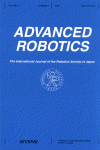
The standing posture transformation gait of a quadruped walking vehicle
For maximizing the mobility of a quadruped walking robot, it is necessary to analyse the versatility and efficiency of the gait-generation method. This paper defines the behaviour of a walking robot, under the title 'standing posture transformation' (abbreviated SPT in this paper),
as the change of its position and posture from an arbitrary standing state to another given standing state. Such SPT or step switching gait is essential for a walking robot when it works in an intended standing posture and/or it transfers from one gait pattern to another. In such behaviour,
especially when the centre of gravity remains unchanged during the transition of the robot, the shift is called 'still SPT'. The analysis of the still SPT is made. It was found that still SPT or step-switching motions, executed six steps at the most, enable the robot to change in any posture.
The probability of realizing an SPT is 25% with four steps without a shift of the centre of gravity, 95% with a shift of the centre of gravity, and 99% by five steps with a shift of the centre of gravity. The optimal generation methods for such motions are clarified. The validity is confirmed
by a computer simulation as well as an experiment using TITAN III, a quadruped walking vehicle designed and built by the authors.
Document Type: Research Article
Affiliations: 1: Faculty of Engineering, Tokyo Institute of Technology, 12-1, Ookayama 2-chome, Meguro-ku, Tokyo 152, Japan 2: Robotics Department, Mechanical Engineering Laboratory of the Agency of Industrial Science and Technology, MITI, Tsukuba Science City, Ibaraki 305, Japan
Publication date: 01 January 1987
- Access Key
- Free content
- Partial Free content
- New content
- Open access content
- Partial Open access content
- Subscribed content
- Partial Subscribed content
- Free trial content